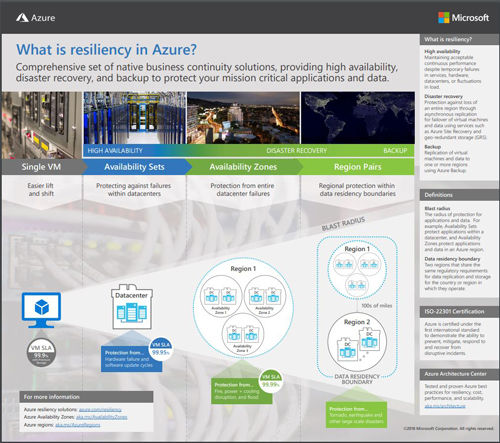News
Azure Availability Zones Come to Microsoft's Cloud Datacenters
- By Kurt Mackie
- April 02, 2018
Microsoft recently starting switching on its first Azure Availability Zones, which provide uptime assurance for cloud workloads.
As of Friday, Azure Availability Zones are now generally available in Microsoft's U.S. Central and France Central regions. The service is at the preview stage in the East U.S. 2, West Europe and Southeast Asia regions.
The new service promises to add resiliency and fault isolation for workloads hosted on Azure infrastructure. Microsoft defines an Azure Availability Zone as "an isolated location inside of an Azure region" that has "its own independent power source, network and cooling."
Each Azure Availability Zone consists of one or more datacenters, and these datacenters are football-field-size facilities, according to an explanation by Microsoft's Raj Ganapathy in this Microsoft video, which demonstrated the setup for Azure Availability Zones.
Organizations can use Azure Availability Zones to protect hosted applications and hosted data from failures within an Azure zone. An Azure zone is defined as "a geographical grouping of Azure regions for billing purposes."
Azure Availability Zones provide protection for the following Azure services, according to Microsoft's overview document:
- Linux Virtual Machines
- Windows Virtual Machines
- Virtual Machine Scale Sets
- Managed Disks
- Load Balancer
- Public IP address
- Zone-redundant storage
- SQL Database
Organizations might use Azure Availability Zones for two basic reasons. They can use them to assure high availability by synchronously replicating applications or data. Alternatively, they can use Azure Availability Zones for disaster recovery purposes by asynchronously replicating applications or data.
Organizations get a 99.99 percent service-level agreement (SLA) assurance of uptime for VMs with Azure Availability Zones, which applies when there are "two or more VMs running in two or more zones in the same region," according to Microsoft's Azure Availability Zones homepage.
Microsoft's overall Azure resiliency scheme is fairly nuanced (see diagram).
 [Click on image for larger view.] Microsoft's Azure resiliency hierarchy. (Source: March 30 announcement)
[Click on image for larger view.] Microsoft's Azure resiliency hierarchy. (Source: March 30 announcement)
Under the Azure resiliency scheme, Microsoft offers 99.9 percent SLAs for single Azure VMs. There's also a 99.95 percent SLA for Azure VMs within datacenters that use Availability Sets, a capability that assures the distribution of VMs across "multiple isolated nodes in a cluster." Here's how a Microsoft document described Availability Sets:
Azure ensures that the VMs you place within an Availability Set run across multiple physical servers, compute racks, storage units, and network switches. If a hardware or Azure software failure occurs, only a subset of your VMs are impacted, and your overall application stays up and continues to be available to your customers.
Ganapathy clarified the difference between Azure Availability Sets and Azure Availability Zones in the video in the context of Microsoft's overall fault-tolerance hierarchy.
"If you could think of that hierarchy of fault tolerance, Availability Sets provide protection from hardware-level failures and software-level update failures," he said. "Availability Zones protect from datacenter-level failures and software update failures."
The pricing for Azure Availability Zones is based on the bandwidth used, namely for both inbound and outbound data transfers, priced at $0.01 per GB going in each direction. There are no data transfer charges between Azure services located in the same region.
Microsoft plans to start billing for Azure Availability Zone data transfers on July 1, 2018.
About the Author
Kurt Mackie is senior news producer for 1105 Media's Converge360 group.